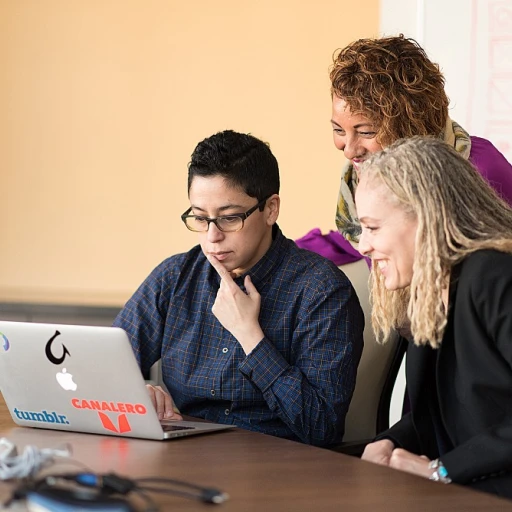
Understanding Team Dynamics
Grasping the Essence of Team Dynamics
Understanding team dynamics is crucial when integrating into a new group. Every team has its unique rhythm and culture, shaped by the interactions and relationships among its members. Recognizing these dynamics early on will help you navigate the complexities of team interactions and improve your overall onboarding experience.
When joining a new team, it's important to observe how team members communicate and collaborate. Pay attention to the unwritten rules and practices that guide their interactions. This awareness will empower you to adapt your communication style and contribute effectively to the team's goals.
Consider the following aspects to better understand team dynamics:
- Communication Patterns: How do team members share information? Is there a preference for formal meetings, or do they rely on informal chats? Understanding these patterns will help you engage more effectively.
- Decision-Making Processes: Observe how decisions are made within the team. Are they consensus-driven, or does a leader make the final call? This insight will guide you in contributing to discussions and initiatives.
- Conflict Resolution: Every team faces conflicts. Understanding how your new team resolves disagreements will help you navigate potential challenges and support team cohesion.
By taking the time to understand these dynamics, you set the stage for building strong relationships with colleagues and adapting to the team's work culture. This foundational knowledge will also be instrumental when leveraging feedback for personal growth and setting personal goals that align with team success.
Building Relationships with Colleagues
Fostering Connections within the Group
Building relationships with colleagues is paramount when seamlessly integrating into a new team. As team members, the initial interactions can set the tone for future collaborations and ultimately, team success. This process isn't just about formal introductions but recognizing the diverse dynamics and individuals within the group. Taking time to engage in intentional team building activities can greatly enhance interpersonal connections. It may seem like a significant investment of time at first, but it pays dividends in making the team process smoother and more effective in the long run. Understanding your colleagues' roles, strengths, and areas where they need support will help improve team cohesion and pave the way for successful projects. In addition to formal team building exercises, fostering an environment where open communication is encouraged will help team members feel valued and a part of the team culture. This can be especially critical during periods of mergers and acquisitions when teams are merging, and members may feel uncertain about their place or the new team dynamics. Empowering team members through collaboration and shared decision-making not only builds trust but also encourages personal and professional development. This layered approach enhances the team's ability to move forward and adapt, particularly in dynamic work environments where mergers or acquisitions are frequent. To achieve these relationships, actively listening and seeking to understand your colleagues is a best practice. This willingness to engage and learn from each other establishes a strong foundation for a collaborative and supportive team environment, ultimately benefiting the whole organization's objectives.Effective Communication Techniques
Facilitating Clear and Constructive Exchange
When joining a new team, effective communication often serves as the cornerstone for a smooth integration and enhanced onboarding experience. It's not just about voicing your opinions but also about actively listening and engaging with team members effectively. This fundamental skill empowers a team to function cohesively as each member is attuned to the group’s goals and individual responsibilities.
To facilitate clear and constructive exchanges within your team, it is important to focus on the following aspects:
- Active Listening: Engage with your colleagues by paying attention to what others are saying and responding thoughtfully. This not only helps build rapport but also enriches collective ideation processes.
- Encouraging Open Dialogue: Foster an environment where everyone feels comfortable sharing ideas and feedback. Open dialogue improves team dynamics and supports a positive working culture.
- Regular Updates: Provide timely updates on your progress and encourage others to do the same. This keeps team members informed and connected to ongoing projects, streamlining collaboration.
- Clear Expectations: Set clear expectations for your role and responsibilities within the team. This clarity ensures that all team members are aligned and can better support one another.
Understanding the nuances of how your team communicates will help you adapt and contribute more effectively. Whether it’s a merger and acquisition situation or a typical team-building exercise, clear communication will always serve as a necessary tool for success. By employing these practices, you contribute not only to your growth but also to that ongoing development of the team, ensuring an inclusive atmosphere where every member will feel heard.
Adapting to the Team's Work Culture
Embracing the Team's Unique Culture
Adapting to a team's work culture is a crucial step in the onboarding process. Each team has its own set of unwritten rules and practices that guide how members interact and collaborate. Understanding these nuances will help you integrate more smoothly and contribute effectively.
To begin, observe how team members communicate and make decisions. Are meetings formal or informal? Do people prefer emails, instant messages, or face-to-face discussions? Recognizing these patterns will help you align your communication style with the team's preferences, enhancing your ability to connect with colleagues.
Another aspect to consider is the team's approach to problem-solving and innovation. Some teams thrive on collaboration and brainstorming, while others may rely on individual expertise. By identifying these tendencies, you can better position yourself to contribute in a way that supports the group's goals.
It's also important to be mindful of the team's values and mission. Aligning your personal goals with the team's objectives not only empowers you but also strengthens the collective effort. This alignment can be particularly beneficial during times of change, such as mergers or acquisitions, where understanding and adapting to a new culture can help the team move forward more cohesively.
Finally, don't hesitate to seek feedback from your team members. Constructive feedback is a valuable tool for personal and professional development. It provides insights into how you can better support the team and improve your own performance. Remember, adapting to a new work culture is an ongoing process, and being open to learning will help you thrive in your new environment.
Leveraging Feedback for Growth
Embracing Constructive Feedback
Feedback is a cornerstone of personal and professional development, especially when integrating into a new team. It serves as a vital tool to help team members understand their strengths and areas for improvement. When you receive feedback, it’s essential to approach it with an open mind and a willingness to learn. This mindset will help you grow and adapt more effectively to the team’s work culture.
In the context of team dynamics, feedback can also be a powerful mechanism to enhance communication and collaboration. By actively seeking feedback from colleagues, you demonstrate a commitment to the team’s success and show that you value their input. This practice not only helps you improve but also fosters a supportive environment where team members feel valued and heard.
Implementing Feedback for Growth
Once you receive feedback, the next step is to implement it effectively. Start by identifying specific areas where you can make changes and set actionable goals to address them. This process will help you measure progress over time and ensure that you are moving forward in your development journey.
- Reflect on Feedback: Take time to reflect on the feedback you receive. Consider how it aligns with the team’s goals and your personal objectives.
- Create an Action Plan: Develop a plan to address the feedback. This could involve learning new skills, adjusting your communication style, or collaborating more effectively with team members.
- Seek Support: Don’t hesitate to ask for help from colleagues or mentors. Their guidance can provide valuable insights and support as you work on your development.
- Monitor Progress: Regularly review your progress and adjust your action plan as needed. This will help you stay on track and continue to grow within the team.
By leveraging feedback effectively, you empower yourself and the team to achieve greater success. This approach not only enhances your individual performance but also contributes to the overall team building process, making the team feel more cohesive and aligned.
Setting Personal Goals for Team Success
Personal Milestones for Team Success
Setting personal goals within a team environment is a crucial step in ensuring both individual and collective success. As you integrate into a new team, it's important to align your personal objectives with the team's overarching goals. This alignment not only empowers you but also contributes to the team's overall development and success.
Here are some best practices to help you set and achieve personal goals that will benefit both you and your team:
- Identify Key Areas for Growth: Reflect on the skills and competencies that will help you thrive in your new role. Consider how these skills can support the team’s objectives and enhance team building efforts.
- Align with Team Objectives: Ensure your personal goals are in sync with the team's mission and values. This alignment will help you contribute more effectively to the team process and improve team dynamics.
- Set Measurable Goals: Establish clear, measurable goals that allow you to track your progress over time. This will help you stay focused and motivated, and provide a way to measure progress in your personal development journey.
- Seek Feedback: Regularly seek feedback from team members and leaders. This feedback will help you refine your goals and adapt to the team's work culture more effectively.
- Celebrate Achievements: Recognize and celebrate your achievements, no matter how small. This practice not only boosts your morale but also encourages a positive team culture.
By setting personal goals that align with the team's objectives, you contribute to a supportive and productive team environment. This approach not only benefits your personal growth but also helps the team move forward, especially in situations involving mergers and acquisitions where team dynamics can be more complex.










